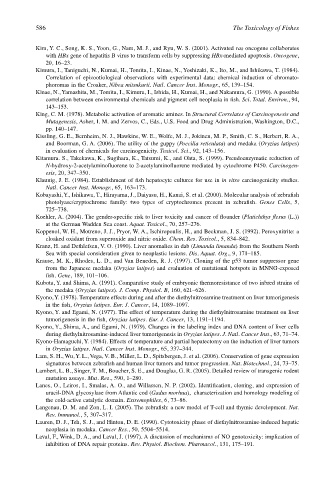Page 606 - The Toxicology of Fishes
P. 606
586 The Toxicology of Fishes
Kim, Y. C., Song, K. S., Yoon, G., Nam, M. J., and Ryu, W. S. (2001). Activated ras oncogene collaborates
with HBx gene of hepatitis B virus to transform cells by suppressing HBx-mediated apoptosis. Oncogene,
20, 16–23.
Kimura, I., Taniguchi, N., Kumai, H., Tomita, I., Kinae, N., Yoshizaki, K., Ito, M., and Ishikawa, T. (1984).
Correlation of epizootiological observations with experimental data: chemical induction of chromato-
phoromas in the Croaker, Nibea mitsukurii. Natl. Cancer Inst. Monogr., 65, 139–154.
Kinae, N., Yamashita, M., Tomita, I., Kimura, I., Ishida, H., Kumai, H., and Nakamura, G. (1990). A possible
correlation between environmental chemicals and pigment cell neoplasia in fish. Sci. Total. Environ., 94,
143–153.
King, C. M. (1978). Metabolic activation of aromatic amines. In Structural Correlates of Carcinogenesis and
Mutagenesis, Asher, I. M. and Zervos, C., Eds., U.S. Food and Drug Administration, Washington, D.C.,
pp. 140–147.
Kissling, G. E., Bernheim, N. J., Hawkins, W. E., Wolfe, M. J., Jokinen, M. P., Smith, C. S., Herbert, R. A.,
and Boorman, G. A. (2006). The utility of the guppy (Poecilia reticulata) and medaka (Oryzias latipes)
in evaluation of chemicals for carcinogenicity. Toxicol. Sci., 92, 143–156.
Kitamura. S., Takekawa, K., Sugihara, K., Tatsumi, K., and Ohta, S. (1999). Pseudoenzymatic reduction of
N-hydroxy-2-acetylaminofluorene to 2-acetylaminofluorene mediated by cytochrome P450. Carcinogen-
esis, 20, 347–350.
Klaunig, J. E. (1984). Establishment of fish hepatocyte cultures for use in in vitro carcinogenicity studies.
Natl. Cancer Inst. Monogr., 65, 163–173.
Kobayashi, Y., Ishikawa, T., Hirayama, J., Daiyasu, H., Kanai, S. et al. (2000). Molecular analysis of zebrafish
photolyase/cryptochrome family: two types of cryptochromes present in zebrafish. Genes Cells, 5,
725–738.
Koehler, A. (2004). The gender-specific risk to liver toxicity and cancer of flounder (Platichthys flesus (L.))
at the German Wadden Sea coast. Aquat. Toxicol., 70, 257–276.
Koppenol, W. H., Motreno, J. J., Pryor, W. A., Ischiropoulis, H., and Beckman, J. S. (1992). Peroxynitrite: a
cloaked oxidant from superoxide and nitric oxide. Chem. Res. Toxicol., 5, 834–842.
Kranz, H. and Dethlefsen, V. O. (1990). Liver anomalies in dab (Limanda limanda) from the Southern North
Sea with special consideration given to neoplastic lesions. Dis. Aquat. Org., 9, 171–185.
Krause, M. K., Rhodes, L. D., and Van Beneden, R. J. (1997). Cloning of the p53 tumor suppressor gene
from the Japanese medaka (Oryzias latipes) and evaluation of mutational hotspots in MNNG-exposed
fish. Gene, 189, 101–106.
Kubota, Y. and Shima, A. (1991). Comparative study of embryonic thermoresistance of two inbred strains of
the medaka (Oryzias latipes). J. Comp. Physiol. B, 160, 621–626.
Kyono, Y. (1978). Temperature effects during and after the diethylnitrosamine treatment on liver tumorigenesis
in the fish, Oryzias latipes. Eur. J. Cancer, 14, 1089–1097.
Kyono, Y. and Egami, N. (1977). The effect of temperature during the diethylnitrosamine treatment on liver
tumorigenesis in the fish, Oryzias latipes. Eur. J. Cancer, 13, 1191–1194.
Kyono, Y., Shima, A., and Egami, N. (1979). Changes in the labeling index and DNA content of liver cells
during diethylnitrosamine-induced liver tumorigenesis in Oryzias latipes. J. Natl. Cancer Inst., 63, 71–74.
Kyono-Hamaguchi, Y. (1984). Effects of temperature and partial hepatectomy on the induction of liver tumors
in Oryzias latipes. Natl. Cancer Inst. Monogr., 65, 337–344.
Lam, S. H., Wu, Y. L., Vega, V. B., Miller, L. D., Spitsbergen, J. et al. (2006). Conservation of gene expression
signatures between zebrafish and human liver tumors and tumor progression. Nat. Biotechnol., 24, 73–75.
Lambert, L. B., Singer, T. M., Boucher, S. E., and Douglas, G. R. (2005). Detailed review of transgenic rodent
mutation assays. Mut. Res., 590, 1–280.
Lanes, O., Leiros, I., Smalas, A. O., and Willassen, N. P. (2002). Identification, cloning, and expression of
uracil-DNA glycosylase from Atlantic cod (Gadus morhua), characterization and homology modeling of
the cold-active catalytic domain. Extremophiles, 6, 73–86.
Langenau, D. M. and Zon, L. I. (2005). The zebrafish: a new model of T-cell and thymic development. Nat.
Rev. Immunol., 5, 307–317.
Lauren, D. J., Teh, S. J., and Hinton, D. E. (1990). Cytotoxicity phase of diethylnitrosamine-induced hepatic
neoplasia in medaka. Cancer Res., 50, 5504–5514.
Laval, F., Wink, D. A., and Laval, J. (1997). A discussion of mechanisms of NO genotoxicity: implication of
inhibition of DNA repair proteins. Rev. Physiol. Biochem. Pharmacol., 131, 175–191.

